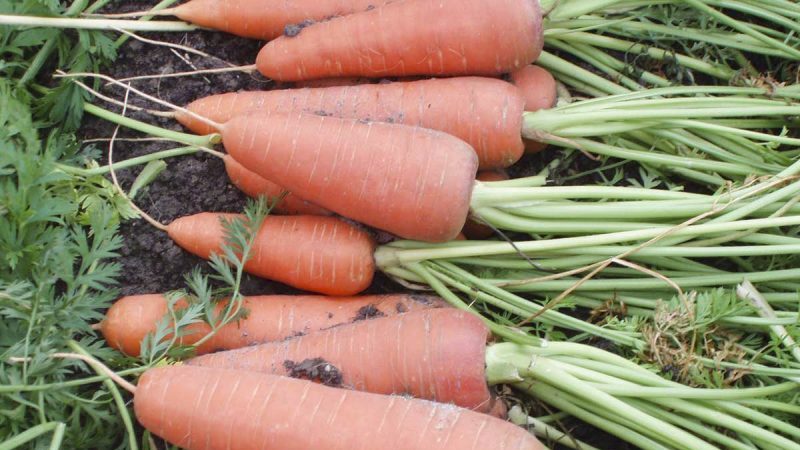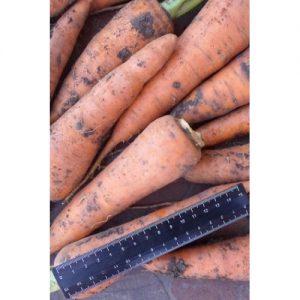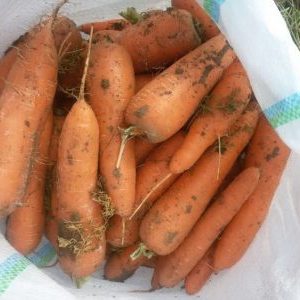Mid-late hybrid of carrots Cascade f1
Carrots are a vegetable crop that is grown by almost every gardener on his site. Growers have different preferences, but there are varieties and hybrids of carrots that are popular with most farmers. One of these hybrids is the F1 Cascade.
The content of the article
Description of the hybrid carrot Cascade
Carrot Cascade is not a variety, but a hybrid belonging to the Shantane variety. Root vegetables can to consume fresh, use for making salads, making juices, baby and dietary food.

Origin and development
Carrot Cascade F1 is a first generation hybrid developed by Dutch breeders of the Bejo Zaden company. It was included in the State Register of Russia in 2006.
Chemical composition, trace elements and vitamins, useful properties
Carrot Cascade F1 contains:
- dry matter - 11.9-15.4%;
- sugar - 7.6-9.4%;
- carotene - up to 16.5 mg;
- trace elements - potassium, calcium, phosphorus, chlorine, iron, magnesium;
- vitamins of group B, PP, K, C, E.
Carrots help the body resist viruses and infections, restores the intestinal microflora and normalizes the gastrointestinal tract, minimizes the risk of developing cancer and vascular diseases, cleanses the body of harmful waste and heavy metal salts, and has a positive effect on male potency.
Ripening period and yield
This is a hybrid of mid-late ripening: about 100-130 days pass between sowing seeds and the onset of technical maturity of root crops.
With proper care and adherence to the rules of agricultural technology, the marketable yield is 250-390 c / ha.
Reference. The maximum yield of this hybrid was recorded in the Moscow region - 450 c / ha.
Disease resistance
The hybrid is resistant to:
- alternaria;
- black rot;
- cercosporosis.
Characteristics, description of appearance, taste

A plant with a semi-spreading leaf rosette, leaves are long, green, coarsely dissected.
Root crops have a fusiform shape with a slightly pointed tip, they reach 18-23 cm in length, and 3-4 cm in diameter, weigh on average 130-170 g.
The surface of the vegetables is smooth, even, the bark and small core are bright orange. Carrots are juicy and sweet taste.
For which regions it is best suited and what is the exacting climate
This hybrid grows well in a variety of climates.
It is included in the State Register for the Central Region, but is also approved for cultivation in the North-West, Volgo-Vyatka, Central Black Earth, North Caucasus, Nizhnevolzhsky, Ural, West Siberian, East Siberian and Far Eastern regions.
The main advantages and disadvantages of a hybrid
Pros of carrots Cascade F1:
- good taste;
- high carotene content;
- long-term storage;
- consistently high yield;
- unpretentiousness;
- the possibility of machine harvesting.
The disadvantage of a hybrid is the inability to use its own seeds.
What is the difference from others
Comparison with other carrot hybrids is presented in the table.
| Hybrid | Ripening terms | Root weight, g | Root crop shape | Productivity, c / ha | Carotene content, mg |
| F1 cascade | 100-130 days | 130-170 | Fusiform with pointed end | 250-390 | Up to 16.5 |
| Bangor F1 | 110 days | 120-200 | Cylindrical with rounded end | 196-270 | 10,1 |
| Fun F1 | 80-100 days | 47-81 | Cylindrical with blunt end | 325-474 | Up to 15.1 |
| Lagoon F1 | 80-85 days | 80-130 | Fusiform with blunt end | 186-316 | Up to 17.2 |
Features of planting and growing
A bountiful harvest can be counted on only if agrotechnical rules are followed. First of all, you should correctly choose and prepare a site for planting carrots and seed, and then provide the plants with proper care.
Preparing for landing
Seed preparation improves seed germination and helps protect plants from disease.
There are several ways to treat seed:
- soak for a day in water heated to + 30 ° C;
- diluted in warm water 1 tbsp. l. ash, wet the seeds with the resulting solution, then rinse them, wrap them in a cloth and put them on the refrigerator shelf for 48 hours;
- wrap the seeds in a cotton cloth, dip them in water heated to + 50 ° C for 2-3 minutes, and then place them in cold water to cool.
In the presence of a bubbler, the inoculum can be placed in a solution of growth stimulants ("Epin", "Silk") with oxygen saturation for 20 hours.
The site is prepared in the fall. The soil is dug up and fertilized at the rate of 30 g of superphosphate, 15 g of potassium, 20 g of nitrogen and 2-3 kg of humus per 1 m². When these requirements are met, in the spring, the ground is only trimmed with a rake.
Ground requirements
Carrots prefers loose, fertile soil with good aeration, moisture permeability and neutral acidity (pH 6-7) - loam, sandy loam, peat soil.
Predecessors
Compliance with the rules crop rotation - one of the conditions for obtaining a high-quality harvest. The best predecessors of the F1 Cascade are potatoes, cucumbers, zucchini, cabbage, garlic, tomatoes, onions, melons and legumes.
Timing, scheme and landing rules
The timing of sowing seeds varies depending on climatic conditions and the purpose of using the crop. Some gardeners carry out sowing before winter in order to collect ripe vegetables as early as possible.
Important! This method is unacceptable in regions with severe winters and where frosts return after thaws.
Most often, planting is carried out in spring, when the daytime temperature is + 15 ... + 18 ° C, and the soil warms up to + 5 ... + 7 ° C.
Landing scheme:
- Form the beds at a distance of at least 15 cm from each other.
- Make furrows in them for sowing seeds.
- Plant the seeds, keeping a distance of 4-5 cm between them and deepening them by 1-2 cm.
- Sprinkle the seeds with earth.
Growing features
For planting carrots, Cascade F1 is chosen a flat, well-lit area where water does not accumulate after rain or snow melting.
In too heavy soil, sawdust soaked in a solution of urea is introduced (1 bucket per 1 m²), and lime, ash and dolomite flour are used to deoxidize the soil.
Attention! Do not plant Cascade F1 after other varieties of carrots, parsley, parsnips, dill and beans.
The nuances of care
This hybrid is not picky about care, but, like other crops, it needs proper watering, feeding and loosening the soil.
Watering mode
The F1 cascade needs regular, moderate watering... Lack of moisture causes poor growth, lethargy and bitterness in the taste of root vegetables, and excessive moisture leads to cracking of vegetables and overgrowth of tops. They are guided by the condition of the soil - it must always be moistened 30 cm deep.
On average, watering is carried out once a week. The water consumption is initially 3 liters per 1 m², and after the second thinning - 10 liters per 1 m². In conditions of drought or active growth of the culture, the volume of water per 1 m² is increased to 20 liters.
Approximately 1.5-2 months before harvesting, the plants are watered once every 10-14 days (10 liters of water per 1 m²), two weeks before harvesting, watering is stopped.
Reference. After watering, the soil is loosened to improve the access of oxygen and moisture to the roots.
Thinning and weed control
It is necessary to promptly remove weeds from the row spacing so that it does not deplete the soil and does not interfere with the development of root crops.
To avoid deformation of carrots, seedlings are thinned twice:
- when 3 leaves appear on the plants (about 3-4 weeks after sowing the seeds), leaving a gap between shoots of 2-2.5 cm;
- after 3 weeks - the distance between the roots should be 4.5-5 cm.
Thinning is performed in the evening, because in the afternoon the smell of carrots attracts pests.
Top dressing
Carrots Cascade F1 are fed twice during the growing season:
- after 21-28 days after germination;
- 2 months after the first feeding.
Fertilizer is a nutrient solution, for the preparation of which 1 tbsp is diluted in 10 liters of water. l. nitrophosphate, 0.5 l of ash, 20 g of potassium nitrate, 15 g of urea and 15 g of double superphosphate.
Important! Fertilizer is applied at the root at the same time as watering.
Disease and pest control
The hybrid is resistant to diseases and attacks of insect pests. If the plants show signs of development diseases or traces of pests, carry out the treatment of plantings with fungicides ("Fundazol", "HOM") or insecticides ("Actellik", "Decis").
Harvesting and storage

Carrots must not only be grown, but also harvested correctly, providing it with suitable storage conditions.
How and when to collect
Despite the fact that the technical maturity of carrots reaches 100-130 days after planting, individual roots can be harvested earlier. If the seeds are sown at the end of April, the harvest is ready for harvest in August.
Carrots are harvested on a dry and clear day by hand (by pulling the roots out of the soil by the tops or digging them up with a shovel) or mechanically.
Storage features and keeping quality of the hybrid
The collected root vegetables are carefully sorted out and discarded or put aside for early use all damaged specimens.
In healthy and whole root crops, the tops are cut to the head, dried in the sun or under a canopy for several days, and then placed in wooden or plastic boxes, poured with sand and taken to a cellar or basement for storage.
Important! Instead of sand, you can use onion peel - it prevents rotting, since it has bactericidal properties.
In suitable conditions, the crop is stored throughout the winter.
What can be the difficulties in growing
When growing Cascade F1, the following problems may arise:
- deformation of root crops in the case of too dense sowing of seeds and lack of thinning;
- cracking of carrots with excessive watering and waterlogging of the soil;
- too small and lethargic roots with a lack of moisture.
Tips from experienced gardeners
Farmers recommendations:
- do not apply fresh manure for crops - an excess of nitrogen-containing fertilizers leads to the appearance of bitterness in the taste of root crops and provokes their cracking;
- monitor the condition of the soil - it must be moistened for the entire length of the root crop;
- store the crop by sprinkling the carrots with onion husks, and if there is not enough of it, make a decoction from it, dip the root vegetables in it and dry them.
Reviews of the hybrid carrot Cascade
Most of the reviews of gardeners about the Cascade F1 hybrid are positive.
Lydia, Yekaterinburg: «I have been growing carrots for a long time, but over the years I have not found a variety whose description would suit me in everything. Several years ago I tried to plant the Cascade on the advice of a kuma and I will not experiment anymore. I like everything - the carrots are smooth, tasty, sweet, the yield is high, and they do not rot during storage. "
Mikhail, Yaroslavl: “Last year I sowed the seeds of the Cascade for the first time and was completely satisfied.I rarely visit the dacha and I cannot carefully look after the plantings, and this carrot does not require that. With scanty care of the beds, the harvest was excellent, preserved until early spring in the cellar. "
Conclusion
Cascade F1 is a first generation carrot hybrid with medium late maturity and suitable for growing in almost all regions. It is resistant to diseases and pests, does not require labor-intensive maintenance.
Root crops are characterized by a pleasant sweet taste, excellent marketability, long-term storage and high carotene content.